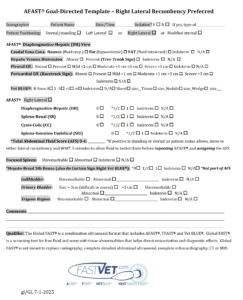Recording your exam findings is extremely important for record keeping and for following progression or improvement of abnormal findings. Our free templates will help you record findings from your Global FAST® point-of-care exam so that you can improve patient care.
Key Point: We recommend always striving for the Global FAST® Approach and not “selective (point-of-care ultrasound, POCUS) imaging” which leads to “Satisfaction of Search Error”, “Confirmation Bias Error”, and “Anchor Bias Error”, any of which lead to potentially catastrophic mismanagement of patients. In other words, “asking a question, and going and looking (POCUS selective imaging)” is a flawed concept.
The analogy would be “selectively” performing a physical examination. When performing a physical exam, we don’t ask questions and then go look/palpate/auscult. No, we do an unbiased set of physical exam systems in the same way every time, otherwise we know we will miss important information (and fail to integrate information/findings that increase the probability of an accurate assessment). So in the same manner, consider your Global FAST® as an “unbiased set of 15 data imaging views.” Think of this Global FAST® Approach mindset as the “point-of-care ultrasound physical exam” of your patient.
After Global FAST®, then and only then you may selectively image by performing as examples 1) a more detailed approach to the heart or gastrointestinal tract, or 2) you may image the soft tissue swelling, or 3) image the eye. However, a Global FAST® is always performed to prevent the said “imaging interpretation errors” noted above. Through our FASTVet courseware, you will see many examples of such “imaging interpretation errors” through the flawed concept of “selective imaging”, i.e., “Cardiac Gallbladder” versus “Anaphylactic Gallbladder.”
My last point, watch a radiologist or cardiologist, they perform their ultrasound examinations the same way every time. Global FAST® is also performed the same way every time. Asking “questions and going and looking (selective imaging)” counters “standardized formats” and by acknowledging these 3 formats – 1) complete detailed abdominal ultrasound, 2) complete detailed echocardiography, and 3) Global FAST® – then systems or regions are not missed. “Picking and choosing (selective imaging)” what is imaged (“asking the question and then going and looking”) by point-of-care ultrasound violates this major principle. We don’t approach radiography (nor physical exams as already mentioned) in this manner either.
********************************************************************************************************************
We love to hear back from you regarding our FASTVet Goal-directed Templates! Email Dr. Greg Lisciandro at LearngGlobalFAST@gmail.com.
Our Goal-directed Templates (“GDTs”) may look busy and intimidating but after taking our courses, you will see that these “GDTs” are really easy to complete quickly by checking the boxes. The GDTs entries will make sense!
The Spleno-Intestino Umbilical (SI-U) View has replaced the old inaccurate name of Hepato-Renal Umbilical View (HR-U). The Spleno-Intestino Umbilical (SI-U) View is a more accurate name because the “AFAST® Target-organs” at this FASTVet Original view are the small intestine and spleen. The probe is placed at the level of the umbilicus and its scanning plane directed into its most gravity-dependent region for free fluid called the “Umbilical Pouch.”
Click here for Individual Goal-directed Templates (GDTs) AFAST®, TFAST®, and Vet BLUE® (Word Document File) for AFAST®, TFAST® and Vet BLUE®
Click here for Global FAST® Template ALL done in Standing (or sternal) Positioning
Click here for Global FAST® beginning in Right Lateral Positioning
The *Word Documents in JPEG form as Quick Reference and may be modified for your practice. We suggest creating 1-3 GDTs with the most common standardized order you will be using at your practice based on patient positioning:
*These are Copyright Protection is for prohibiting commercial use and electronic distribution without our permission. You may willingly modify our GDTs for your practice. We ask that you share with colleagues FASTVet as your source.
AFAST®

TFAST®

Vet BLUE®

gl/GL 7-1-2025




